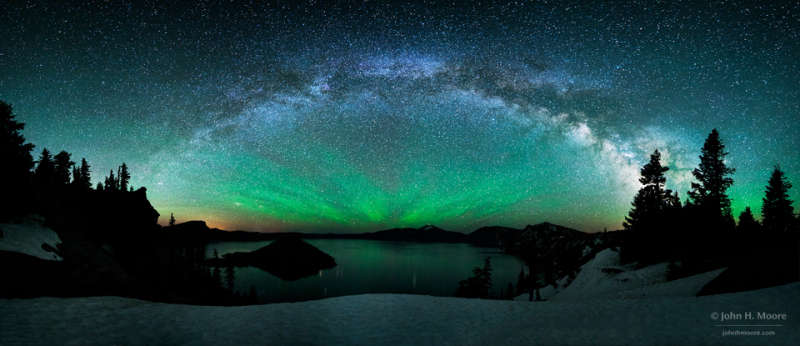Credit & Copyright: Judy Schmidt
Explanation:
How many different astronomical phenomena have come together to create the above
vista?
Several.
First, in the foreground, is
Crater Lake --
a caldera created by volcanism on planet Earth about 7,700 years ago.
Next, inside the lake, is water.
Although the origin of the water in the crater is melted snowfall,
the origin of water on Earth more generally is
unclear,
but possibly related to ancient Earthly-impacts of
icy bodies.
Next, the green glow in the sky is
airglow,
light emitted by atoms high in the Earth's atmosphere as they recombine
at night after being separated during the day by energetic sunlight.
The many points of light in the sky are stars, glowing by
nuclear fusion.
They are far above the atmosphere but
nearby to our Sun in
the
Milky Way Galaxy.
Finally, the bright arch across the image is the
central band of the Milky Way,
much further away, on the average, than the nearby stars, and
shaped mostly by gravity.
Contrary to appearances, the Milky Way band glows by
itself and is not illuminated by the airglow.
The above image is a six-frame panorama taken during about two weeks ago in
Oregon,
USA.
1999 2000 2001 2002 2003 2004 2005 2006 2007 2008 2009 2010 2011 2012 2013 2014 2015 2016 2017 2018 2019 2020 2021 2022 2023 2024 2025 |
Yanvar' Fevral' Mart Aprel' Mai Iyun' Iyul' Avgust Sentyabr' Oktyabr' Noyabr' Dekabr' |
NASA Web Site Statements, Warnings, and Disclaimers
NASA Official: Jay Norris. Specific rights apply.
A service of: LHEA at NASA / GSFC
& Michigan Tech. U.
|
Publikacii s klyuchevymi slovami:
Milky Way - Mlechnyi Put' - nochnoe nebo
Publikacii so slovami: Milky Way - Mlechnyi Put' - nochnoe nebo | |
Sm. takzhe:
Vse publikacii na tu zhe temu >> | |
